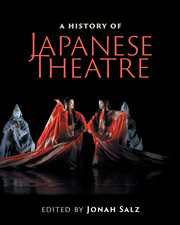Book contents
- Frontmatter
- Contents
- List of figures
- List of tables
- Contributors
- Contributors’ biographies
- Foreword
- Acknowledgments
- Note on Japanese terms
- List of abbreviations
- Timeline
- Editor's introduction
- I Traditional theatres
- Preface to Part I Japanese civilization arises
- 1 Ancient and early medieval performing arts
- Interlude Katari narrative traditions: from storytelling to theatre
- 2 Noh and Muromachi culture
- Interlude Noh and kyogen costumes and masks
- 3 Kyogen: classical comedy
- Interlude Iemoto : the family head system
- 4 Kabuki: superheroes and femmes fatales
- Interlude Nihonbuyo: classical dance
- Interlude Okinawan theatre: boundary of Japanese theatre
- 5 Bunraku: puppet theatre
- Interlude Misemono and rakugo : sideshows and storytelling
- Interlude Kamigata geinō : Kyoto-Osaka style
- Interlude Traditional theatre tomorrow: interview with Takemoto Mikio
- II Modern theatres
- Preface to Part II
- III Arcs and patterns
- IV Theatre architecture
- Preface to Part IV Evolution of Japanese theatre architecture
- V Theatre criticism
- VI Intercultural influences
- Epilogue: Frozen words and mythology
- Further reading
- Index
- References
Interlude Katari narrative traditions: from storytelling to theatre
from Preface to Part I Japanese civilization arises
Published online by Cambridge University Press: 05 July 2016
- Frontmatter
- Contents
- List of figures
- List of tables
- Contributors
- Contributors’ biographies
- Foreword
- Acknowledgments
- Note on Japanese terms
- List of abbreviations
- Timeline
- Editor's introduction
- I Traditional theatres
- Preface to Part I Japanese civilization arises
- 1 Ancient and early medieval performing arts
- Interlude Katari narrative traditions: from storytelling to theatre
- 2 Noh and Muromachi culture
- Interlude Noh and kyogen costumes and masks
- 3 Kyogen: classical comedy
- Interlude Iemoto : the family head system
- 4 Kabuki: superheroes and femmes fatales
- Interlude Nihonbuyo: classical dance
- Interlude Okinawan theatre: boundary of Japanese theatre
- 5 Bunraku: puppet theatre
- Interlude Misemono and rakugo : sideshows and storytelling
- Interlude Kamigata geinō : Kyoto-Osaka style
- Interlude Traditional theatre tomorrow: interview with Takemoto Mikio
- II Modern theatres
- Preface to Part II
- III Arcs and patterns
- IV Theatre architecture
- Preface to Part IV Evolution of Japanese theatre architecture
- V Theatre criticism
- VI Intercultural influences
- Epilogue: Frozen words and mythology
- Further reading
- Index
- References
Summary
Sung, spoken, or chanted narrative (katari) has a central place in noh, bunraku, and kabuki. Why did these theatrical forms retain the narrative voice and a narratorial onstage presence? One factor is the religious origins of narrative. In Japan's ancient and strongly shamanistic religion, a medium (miko) goes into trance, receiving and then transmitting messages from gods to humans. She uses narrative, song, and dance (mai), perhaps beating a drum or twanging a catalpa bow or other stringed instrument, believed efficacious in contacting spiritual realms. The earliest miko were often blind women who worked for shrines, or formed independent itinerant associations. The legends, myths, and genealogies of clan rulers contained in the Kojiki (712) were memorized, ritually recited, and orally transmitted by professional blind male narrators (kataribe). Eventually, narrative developed rich musical resources, generating diverse genres of sung narrative.
With the spread of Buddhism from the continent (sixth century), preaching the new faith called upon and blended with local narrative practices. In temples, a musical preaching called kōshiki (“lecture service”) developed (tenth century): the officiating priest read a text based on sutras to instruct and inspire devotion. Although written in literary Chinese, it was delivered musically in Japanese, employing similar musical structures to later storytelling genres.
Preaching in temples was complemented by itinerant purveyors of Buddhism in streets and market places: storytelling monks; holy men of Mount Kōya; nuns (bikuni) of Kumano; e-toki (lit. “painting explicators”), who pointed to religious paintings while preaching about heaven and hell or saints’ lives.
Heroic tales into drama: Heike, Soga, and Kōwaka
Two enduring narratives of the medieval era were the Heike and Soga cycles. The battles between the Heike and Minamoto clans (1180–5) were recounted in oral tales and written records that gradually coalesced into The Tales of the Heike. While the textual tradition has dozens of versions, it also thrived for centuries as a performance tradition under shogunal patronage, performed exclusively by blind male quasi-priests (biwa hōshi) who accompanied themselves on a pear-shaped four-stringed lute (biwa). Initially recited to placate the souls of those felled in battle so they would not wreak havoc on the living, Heike uses melodic patterns ranging from syllabic chant to highly melismatic extended melodies.
- Type
- Chapter
- Information
- A History of Japanese Theatre , pp. 20 - 23Publisher: Cambridge University PressPrint publication year: 2016



